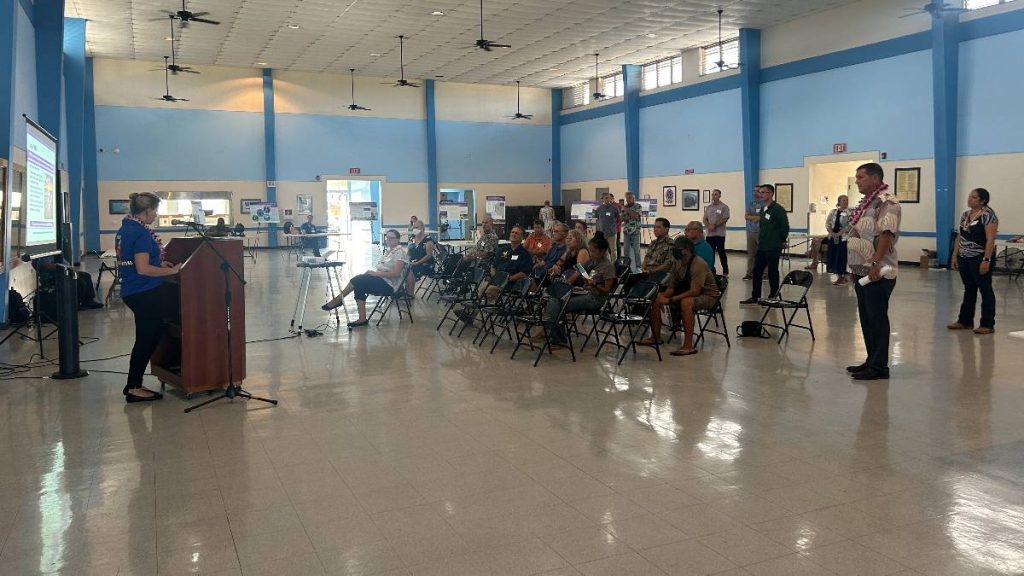U.S. Navy seeks public input on proposed increase in military training on Kauaʻi, uninhabited island
Officials with the U.S. Navy on Tuesday unveiled the draft environmental assessment of proposed plans at the Pacific Missile Range Facility on Kauaʻi to significantly increase the amount of military training, bomb exercises and other activities, saying impacts would be minimal.
The Navy wants to increase the frequency of 13 types of land-based and multi-domain training and testing activities at Barking Sands and Kaʻula Island, an uninhabited Hawaiian island located about 20 nautical miles southwest of Kauaʻi and Niʻihau that has been used as a bombing range since 1952. The dropping of inert bombs on land targets occurs on Ka’ula Island.
During the public meeting at the Kaua’i Veteran’s Center in Lihu’e, officials emphasized that the location and kind of training won’t change, only the number of times each year these operations and exercises will be conducted.
“No new types of training or testing activities are being proposed,” said Brian Whitehouse, a National Environmental Policy Act project manager with the U.S. Pacific Fleet who worked on the environmental assessment.
The draft environmental assessment, which is more than 200 pages, focuses on the effects on the land where heightened activity is proposed, which includes 7,659 acres on the missile range facility and 113 acres at Ka’ula Island.

It does not include surrounding areas of Port Allen, Koke’e, Makaha Ridge or Ni’ihau “because there are no proposed changes in activity at those locations,” which were last analyzed in 2008, according to the document.
The draft environmental assessment said the proposed increases are expected to result in minor or “less than significant” impacts in all categories analyzed: air quality, climate change, greenhouse gas emissions, public health and safety, wildlife, vegetation and noise.
The National Environmental Policy Act, a 1970 federal law, mandates that federal agencies assess the impacts of their environmental actions before making decisions.
The purpose of the heightened activity at the Pacific Missile Range Facility is to support military readiness. So when a force is needed, “they’ll be ready,” Whitehouse said.
According to the draft environmental assessment, U.S. military officials are seeking increases in the number of times each year these 13 training and testing activities are conducted:
- Launching missiles, rockets and aerial target drones from established launch areas: increase from 25 to 35.
- Missile and aerial drone target set-up preparation (with no launch): increase from 1 to 6.
- Live firing artillery exercises at water or air targets: increase from 1 to 3.
- “Amphibious operations:” Practice raids, where forces move from amphibious ships at sea, landing via various vessels, and conducting follow-up activities ashore: increase from 1 to 2. Small boat operations: increase from 2 to 19. (This operation uses units to move small boats from offshore to a beach landing site, carrying the boat inland, surveying the area, and then returning to the sea.) And swimmer insertion/extraction at Barking Sands’ amphibious landing areas: increase from 1 to 2.
- FARP (Forward Arming and Refueling Point) operations, which involve re-fueling and re-deploying helicopters and other aircrafts: increase from 1 to 20.
- Operation launches, and controls of small unmanned aircraft systems or drones: increase from 2 to 45. Counter-unmanned aircraft systems operations, or anti-drones, also would increase by the same amount.
- Parachute operations: 1 to 16.
- Intelligence and target exercise, which includes personnel establishing and operating a field command post, communications system, radar tracking and surveillance systems, optical tracking systems, and electronic warfare equipment operated on concrete areas or by mobile vehicles: 9 to 70.
- Bivouacs, or temporary tents or camps used in the field for personnel training at various Barking Sands locations: 9 to 47.
- Air-to-ground gunnery exercises, which involve personnel employing guns and inert rockets to attack ground targets on Kaʻula Island: 14 to 24.
- Air-to-ground bombing exercises, which involve training a striker fighter aircraft to drop inert bombs on land targets at Kaʻula Island: 12 to 31.
- Helicopter/tilt rotor landing zone operations to practice landing and takeoffs at Barking Sands: 1 to 12.
- Ground maneuvers: 1 to 22 annual activities.
Of the 13 proposed increases, the air-to-ground bombing and utility exercises are the only two proposed to take place on Ka’ula Island. The others will be held using the existing training and testing sites on the military grounds.
The draft environmental assessment said the increased training and testing activities would not increase public health and safety risks for military personnel or the public. It also said that any disturbances to historical or cultural materials are unlikely, and if any cultural materials are found, all activities in the vicinity would immediately stop.
Damage to vegetation and wildlife is also expected to be minimal, especially due to the sparse vegetation on Kaʻula Island. The assessment found any displacement of wildlife, including Hawaiian monk seals, is expected to be “less than significant.”
Multiple officials at the event said the increases would include mitigation measures that would maintain and protect both the wildlife and cultural resources in the area.
The military takes environmental concerns “very seriously,” said Fred Styer, a range sustainment office coordinator at the missile range facility. He also focuses on the facility’s compliance with the National Environmental Protection Act.
“We’re increasing the protection,” he said. “Matter of fact, the nēnē population, it’s grown so much that now it’s hard to drive (at the facility) because they’re everywhere.”
He said the goal is to make sure the facility does everything right so it can continue to conduct the military operations and exercises.
“If we don’t do the right thing, the U.S. Fish and Wildlife Service has the authority to say no,” Styer said.
Jakki Nelson, a 2024 candidate for Kaua’i County Council after finishing 13th in the primary, was one of less than 20 Kaua’i residents who attended the public meeting.
“It looks like they were just going through all the necessary hoops they have to jump through for environmental impact,” she said. “Looks like they have their ducks in a row.”
Nelson added she was less concerned after learning that the training activities would be conducted on the same land already in use.
Nelson also was surprised by the small turnout by the public: “It always amazes me because this is important stuff. And the more people asking different questions, the more information we’re going to have.”
No one at the meeting voiced concern about the proposed plans.
The full draft environmental assessment is available for public review and comment through Sept. 30 at 11:59 p.m., when people are able provide feedback on the assessmentʻs “accuracy and adequacy.” It also considers a “no-action alternative,” where current activity remains the same.
The Pacific Missile Range Facility’s communications office asks members of the public to email comments or concerns to PMRF-LBT-EA-Comments@us.navy.mil.
Comments are also being accepted by postal mail to the address below:
Naval Facilities Engineering Systems
Command Pacific/EV22
Attention: PMRF LBT EA Project Manager
258 Makalapa Drive, Suite 100
Pearl Harbor, HI 96860
The final environmental assessment is expected to be completed in January 2025. As stated in the draft, if the assessment finds that there are significant impacts which cannot be mitigated to “less than significant,” then an environmental impact statement must be prepared.
The Navy is currently in the process of creating an environmental impact statement to be reviewed by the state Department of Land and Natural Resources when it decides on the nearly 9,000 acres of Pacific Missile Range Facility lands that the state has leased to the Navy and NASA for more than 65 years, with lease agreements set to expire in 2027 and 2030. However, the plan to increase training is on the facility-owned land, not on the leased land.
Corrections:
- This story has been updated to correct a typo in the email address for where to send comments.









